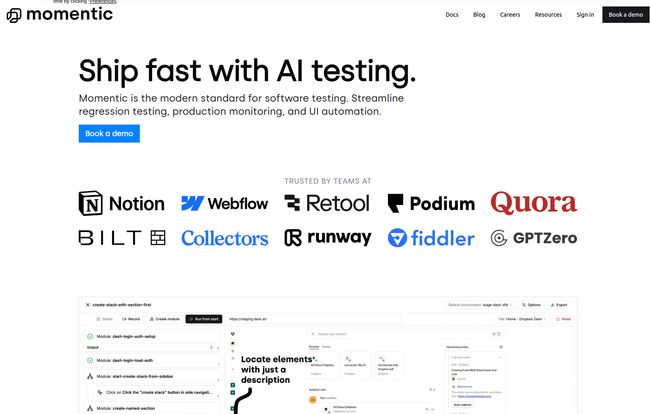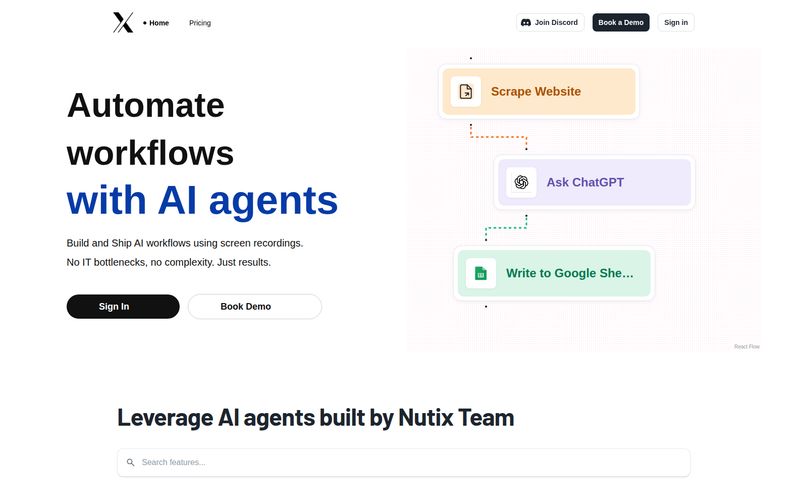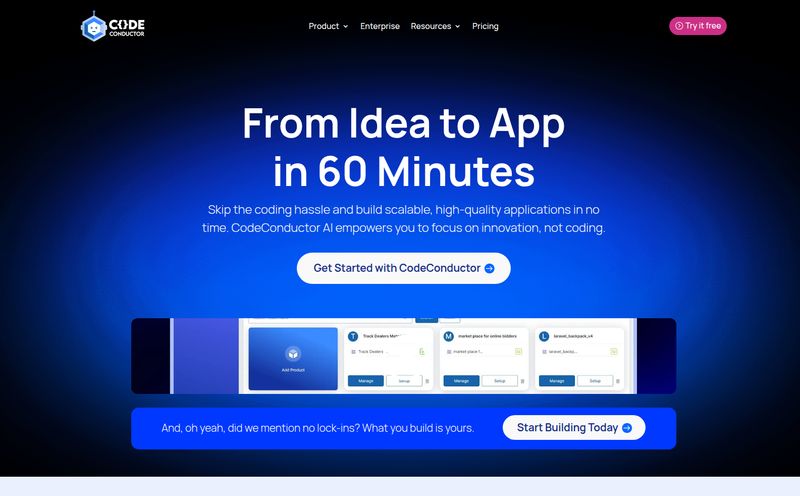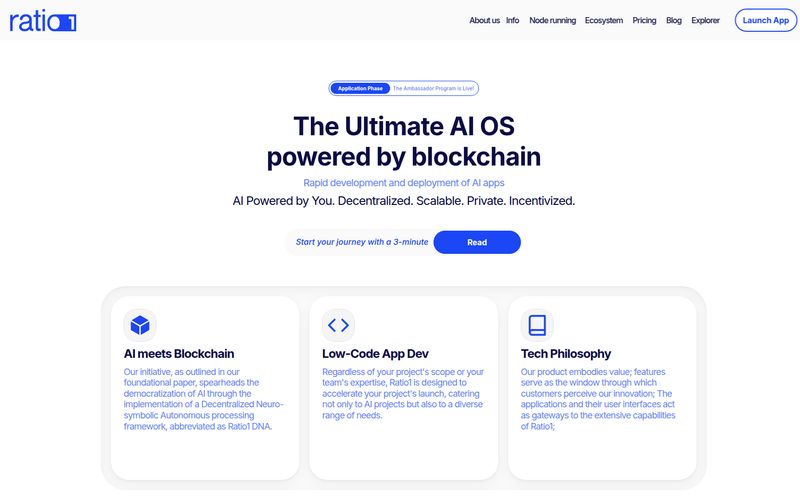Let’s have a little chat. If you’ve been in the software world for more than a few months, you know the drill. You build a cool new feature. You write some tests. The tests pass. You ship it. Everything is great. Then, a week later, half your test suite is failing. Not because the feature is broken, but because a developer innocently changed a CSS class name or refactored a component.
I’ve spent more nights than I care to admit fighting with Selenium locators and debugging brittle end-to-end tests. It’s a grind. It's the part of the job that makes you question your life choices. So, when a tool comes along that claims to use AI to fix all that, my ears perk up. But let's be honest, my skepticism meter also goes through the roof. The latest tool to make these bold claims? Momentic.
I’ve seen their name pop up, especially since they're trusted by some serious players like Notion, Webflow, and Retool. So I decided to dig in and see if this is just more AI hype or if it’s the real deal.
So, What is Momentic, Really?
At its core, Momentic is an AI-powered testing platform designed to take the headache out of UI and regression testing. Think of it less as a direct replacement for something like Playwright or Cypress, and more as a new layer on top that orchestrates everything with a heavy dose of artificial intelligence. The goal is simple: let engineers build and ship faster without getting bogged down by maintaining a fragile, time-consuming test suite.
It’s built for modern engineering teams who want to move quickly but still maintain a high bar for quality. Instead of spending hours writing and updating complex test scripts, the idea is you can build, debug, and analyze tests in a fraction of the time. A lofty promise, for sure.
The Features That Actually Matter
Okay, let's get past the marketing fluff. A tool is only as good as its features, and Momentic has a few that are genuinely interesting. They aren't just bolting on a ChatGPT wrapper; they seem to have rethought the entire testing workflow from the ground up.
AI-Powered Assertions: Speaking English to Your Tests
This is probably the coolest, most mind-bending feature. Traditionally, when you want to verify something in a test, you write an assertion in code. Something like expect(page.locator('#user-greeting')).toHaveText('Welcome, Bob!'). It works, but it’s rigid.
Momentic flips this on its head. You can write your assertions in plain English. For example, you could just tell the AI, “Verify the success message is visible and contains the user’s name.” The AI then understands the intent and generates the necessary check. This is a huge leap. It feels less like programming and more like a conversation with a junior QA assistant who just gets it. This lowers the barrier to entry and makes tests so much more readable.
Auto-Healing Locators: The End of Flaky Tests?
If you've ever yelled at your screen because of a NoSuchElementException, this one's for you. Maintaining flaky tests is like trying to build a house of cards during a mild earthquake. A tiny change to the UI, and everything comes crashing down.
Momentic’s “auto-healing locators” are designed to solve this. Instead of relying on a strict XPath or CSS selector, the AI understands an element by its context on the page—its position, its text, its relationship to other elements. So if a class name changes but the button is still a blue “Submit” button under the main form, Momentic’s AI is smart enough to find it. I’m still a bit wary—I'd want to see how it handles really complex, dynamic UIs—but the promise of never having to manually update a selector again is… well, it’s everything.

Visit Momentic
The Low-Code Editor: Surprisingly Intuitive
When I hear “low-code,” I usually cringe a little. It often means a clunky drag-and-drop interface that’s more limiting than helpful. But the editor in Momentic feels different. It’s a clean, visual interface where you can see your app on one side and the test steps on the other. You can add steps like clicks and inputs, and then use the AI to generate the more complex parts, like assertions.
It strikes a nice balance. It’s simple enough for a product manager or a frontend developer to quickly build a test flow, but it seems to have the depth needed for serious QA work. Plus, it provides all the debugging tools you'd expect—video replays, network logs, and DOM snapshots—right there in the UI. Very slick.
The Real-World Impact: Does Momentic Actually Speed Things Up?
Features are nice, but what about results? The testimonials are pretty compelling. The engineer from Retool mentioned setting up an end-to-end test across 110 different prompts that ran in under a minute. That’s just wild. For any team that’s ever waited 45 minutes for their CI/CD pipeline to finish its testing stage, that kind of speed is a game-changer.
It seems the main benefit isn't just writing tests faster, but the dramatic reduction in maintenance overhead. If the AI can handle 80-90% of the maintenance caused by minor UI tweaks, that frees up an enormous amount of engineering time. Time that can be spent building features that customers actually pay for, not appeasing a cranky test runner.
Let's Be Real: The Potential Downsides
Alright, it can't all be sunshine and rainbows. I have to put my cynical hat back on for a moment.
- Reliance on AI: What happens when the AI gets it wrong? Relying on a “black box” for your core quality process can be unnerving. You're putting a lot of trust in Momentic’s models.
- Learning Curve: While it’s low-code, it’s not no-code. It's a new platform with its own way of doing things. Teams will still need to invest time in learning its quirks.
- Cloud Dependency: While you can run tests locally, the brain of the operation is in Momentic's cloud. If their service has an outage, you might be stuck. This is a common concern with any SaaS platform, but especially critical for a testing tool.
These aren't deal-breakers, but they are important things to consider. This feels like a tool for teams willing to embrace a new way of working, not for those who want to keep their old processes but just add a little AI spice.
How Does Momentic Pricing Work?
Ah, the million-dollar question. Or, hopefully, less. If you go to Momentic's website, you won't find a pricing page with neat little tiers. Instead, you'll see a big, friendly “Book a Demo” button.
This is typical for enterprise-focused B2B software. It means pricing is likely custom and based on your team's size, usage needs, and specific requirements. On one hand, this allows for tailored plans. On the other, it can be a barrier for smaller teams or developers who just want to kick the tires without talking to a sales rep. Personally, I always prefer transparent pricing, but I understand the model for a high-touch product like this.
Who Should Actually Use Momentic?
After digging in, I have a pretty clear idea of who would benefit most from a tool like Momentic. It’s perfect for fast-moving startups and scale-ups in the tech space—the kind of companies that live and die by their shipping velocity. If your team is constantly frustrated with maintaining a bloated Cypress or Selenium suite and wants to empower all engineers to contribute to quality, Momentic could be a fantastic fit.
However, if you're a hobbyist, a very small team on a tight budget, or a large enterprise with a deeply entrenched (and functioning) testing framework, it might not be the right move. It represents a significant shift in workflow, and the custom pricing model probably puts it out of reach for casual users.
Final Thoughts: A Glimpse into the Future of QA
I came into this review skeptical, but I'm leaving… cautiously optimistic. Momentic is more than just a tool; it's an opinionated take on what software testing should be. It argues that human time is better spent on defining intent (“what should this page do?”) rather than implementation (“what is the exact CSS selector for this button?”).
It won't be for everyone, and the reliance on AI will make some old-school engineers nervous. But it tackles a real, expensive, and frustrating problem in a novel way. If Momentic can deliver on its promises of speed and stability, it might not just be a good tool—it might be the future of how we ensure software quality.
Frequently Asked Questions About Momentic
- What kind of AI does Momentic use?
- According to their site, they use a combination of multi-modal AI models that are specifically trained for software testing tasks. This isn't just a generic language model; it's purpose-built to understand UI elements and user flows.
- Can I run my tests on my own machine?
- Yes. Momentic is flexible, allowing you to run tests in their cloud, locally on your own machine, or as part of your existing CI/CD pipeline (like GitHub Actions). This is great for both quick local debugging and full regression runs.
- Is Momentic just a fancy Playwright code generator?
- No, it's a complete platform. While it integrates with frameworks like Playwright, it's not just generating code that you then have to manage. It's a full ecosystem for creating, managing, running, and analyzing tests.
- Does Momentic support mobile app testing?
- Not for native iOS and Android apps at the moment. However, it does support testing for desktop applications built with Electron, in addition to web apps.
- How reliable are tests that use AI to find elements?
- This is the key question. The entire premise is that they are more reliable than traditional selectors because the AI understands context. Instead of breaking on a simple name change, it adapts. The company claims this leads to more robust and less flaky tests over time.



